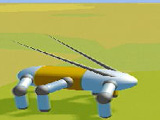
This simulation was created in order to show the simplicity and ease of using a Virtual Model Control scheme. This control scheme is the same method used by Spring Turkey, the planar biped walking robot. The hexapod, however, is a more complex multi-linked, parallel mechanism. Each of its six legs has six degrees of freedom with two actuated pin joints at the hip and one actuated pin joint at the knee. There are no constraints on the motion of the hexapod, making it a true three dimensional robot able to move in the x, y, z, roll, pitch, and yaw directions.
Since robots are typically designed with an individual actuator at each joint, the control of these systems is often difficult and non-intuitive. The use of Virtual Model Control allows for the development and implementation of a more intuitive control scheme for these complex systems. This method produces a straightforward means of controlling joint torques to produce a desired robot behavior.
Although the hexapod is a highly non-linear, parallel mechanism, the use of virtual models allows text-book control solutions to be implemented while the robot is walking. The hexapod is able to trace out a number of interesting paths which only require the specification of three inputs (velocity magnitude, velocity angle, and turning rate of the body). Using a simple linear control law, the robot walked while simultaneously balancing a pendulum and tracking an object.
In order to show the ease and usefulness of this control scheme, a pendulum was attached to the back of the hexapod. This pendulum was attached via two pin joints. Using a simple linear control law, the robot was able to walk complex patterns while balancing the pendulum.
